|

The Accumulation
of Disadvantage: The Role of Educational Testing in the School Career
of Minority Children
Sandra Mathison
1.1 This
paper discusses the ways standardized testing puts children of color and
children living in poverty at a disadvantage. This disadvantage begins
early in the school career of a child and repeats itself again and again.
Education, when driven by standardized testing, is not the great equalizer
it is so often portrayed to be in the mythical world where merit counts
most.
Testing in K - 12
2.1
Testing starts early and it occurs often in the life of an average student,
even more often if a student is at either end of the achievement spectrum,
i.e. gifted or has learning disabilities. In a recent analysis of the
U.S. Department of Education’s Early Childhood Longitudinal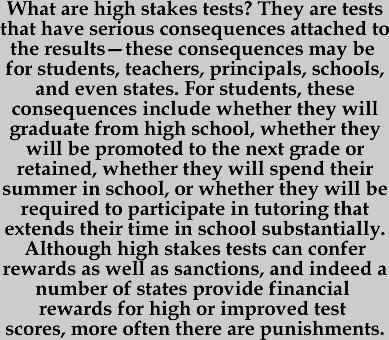 Study, Kindergarten Cohort (ECLS-K), Lee & Burkam (2002) conclude:
"There are substantial differences by race and ethnicity in
children’s test scores as they begin
kindergarten. Before even entering kindergarten, the average cognitive
score of children in the highest SES group are 60% above the scores of
the lowest SES group. Moreover, average math achievement is 21% lower
for blacks than for whites, and 19% lower for Hispanics." Setting aside
the unjustified confidence in the meaningfulness of standardized test
scores for young children (Association for Childhood Education International,
1991), this report illustrates just the beginning of a lifetime of characterizations
and decisions that will be made and indeed institutionalized for children
of color and those living in poverty.
Study, Kindergarten Cohort (ECLS-K), Lee & Burkam (2002) conclude:
"There are substantial differences by race and ethnicity in
children’s test scores as they begin
kindergarten. Before even entering kindergarten, the average cognitive
score of children in the highest SES group are 60% above the scores of
the lowest SES group. Moreover, average math achievement is 21% lower
for blacks than for whites, and 19% lower for Hispanics." Setting aside
the unjustified confidence in the meaningfulness of standardized test
scores for young children (Association for Childhood Education International,
1991), this report illustrates just the beginning of a lifetime of characterizations
and decisions that will be made and indeed institutionalized for children
of color and those living in poverty.
2.2 Beginning in Kindergarten, test results are used to sort, track, and monitor
the abilities, achievements, and potentials of students. Assessments,
based in part on standardized test results, are essential for monitoring
the progress of children, for making instructional and curricular decisions,
and for evaluating programs and policies. The danger is that standardized
test results will be weighed more heavily than they ought to be, that
decisions once made cannot or will not be reversed, and that other compelling
information may be ignored.
2.3
The uses of standardized testing are more far ranging
than most people realize. While there is considerable variation from one
district to the next, children will be administered at least one but typically
many more standardized tests within a single year. The following table
illustrates the testing experience of a child from Kindergarten through
high school in an upstate New York school district.
| Grade |
Test |
| Kindergarten |
Boehm Test of Basic Concepts |
| 1st |
Gates MacGinitie Reading Test* |
| 2nd |
Gates MacGinitie Reading Test*
Stanford Diagnostic Math Test*
Terra Nova (reading & math)
|
| 3rd |
Gates-MacGinitie Reading Testing*
Stanford Diagnostic Math Test*
Terra Nova (reading & math)
School & College Ability Test
(SCAT)**
Cognitive Abilities Test (CogAT)
|
| 4th |
Gates MacGinitie Reading Test*
Stanford Diagnostic Math Test*
School & College Ability Test
(SCAT)**
NYS English Language Arts Test
NYS Math Test
NYS Science Test
|
| 5th |
Gates MacGinitie Reading Test*
Stanford Diagnostic Math Test*
Terra Nova (reading & math)
School & College Ability Test
(SCAT)**
NYS Social Studies Test
|
| 6th |
Terra Nova (reading & math)
School & College Ability Test
(SCAT)**
|
| 7th |
Terra Nova (reading & math)
Cognitive Abilities Test (CogAT)
|
| 8th |
NYS English Language Arts Test
NYS Math Test
NYS Science Test
NYS Social Studies Test
NYS Foreign Language Test
NYS Technology Test
|
| 9th |
Regents Exams:
PSAT
SAT
|
| 10th |
| 11th |
| 12th |
* for remedial
students only
** Johns
Hopkins Talent Search test for gifted program
Figure 1.
An Illustration of the Testing in the Life of a Student
The
Case of High Stakes Tests
3.1 What
are high stakes tests? They are tests that have serious consequences attached
to the results—these consequences may be for students, teachers, principals,
schools, and even states. For students, these consequences include whether
they will graduate from high school, whether they will be promoted to
the next grade or retained, whether they will spend their summer in school,
or whether they will be required to participate in tutoring that extends
their time in school substantially. Although high stakes tests can confer
rewards as well as sanctions, and indeed a number of states provide financial
rewards for high or improved test scores, more often there are punishments.
These punishments can be direct (such as taking over or closing school,
replacing administrators or teachers, or withdrawing accreditation) or
indirect (such as publishing test scores in the local newspaper, shaming,
or job reassignment).
3.2
Although high stakes testing has become a national
phenomenon, there are some clear patterns illustrating who is most likely
to be subjected to these tests. High stakes testing is disproportionately
found in states with higher percentages of people of color and living
in poverty. A recent analysis of the National Educational Longitudinal
Survey (NELS) shows that 35% of African American and 27% of Hispanic 8th
graders will take a high stakes test, compared to 16% of whites (Reardon
& Galindo, 2002). Looked at along class lines, 25% of low SES 8th
graders will take a high stakes test compared to 14% of high SES 8th
graders.
3.3
The Quality Counts (2001) report indicates that of
the 18 states that require passing a standardized test to graduate, 11
are in the south, i.e., states with substantial minority populations.
As more states adopt high school graduation tests this relationship will
weaken some—26 states in all plan to have such a test—14 of those are
in the south or southwest regions of the country. States that currently
use high school graduation exams to grant or withhold diplomas are Alabama,
Florida, Georgia, Indiana, Louisiana, Maryland, Minnesota, Mississippi,
Nevada, New Jersey, New Mexico, New York, North Carolina, Ohio, South
Carolina, Tennessee, Texas, and Virginia. States that are developing high
school exit exams are Alaska, Arizona, California, Delaware, Hawaii, Massachusetts,
Utah, Washington, and Wisconsin.
3.4
And, not only are students of color more likely to
take high stakes tests, but they also score lower than white students.
From the websites of a sample of any state departments of education (for
illustrative purposes Massachusetts, New York, and Kentucky are described
here) one can demonstrate this conclusion. Last year in Boston, 43% of
white students failed the tenth grade math test, 85% of Hispanic students
failed. In Schenectady NY 62% of children of color failed the 4th
grade ELA, 41% of white students failed. In neighboring Albany school
district, 68% of children of color failed this test, compared to 33% of
whites. In Kentucky's Jefferson County Public Schools, scores on reading
tests demonstrate the same relationship: 63% of white 4th graders
were proficient, compared to 34% of African American children; 54% of
white 7th grade students were proficient, compared to 27% of
African Americans; and in 11th grade 37% of whites were proficient
compared to 13% of African American students.
3.5
The remainder of this discussion will focus on three
outcomes of high stakes testing, and the ways in which minority children
are particularly disadvantaged.
- the disproportionate impact of
state testing on drop out rates for minorities
- the bizarre effect of monetary
rewards for students, and
- the diminishment in the quality
of education as a consequence of testing, for all but especially for
minority students when differential performance on tests is translated
into the "achievement gap"
The Impact of Testing on Drop Out
Rates for Minorities
4.1
Both graduation tests and tests given earlier in a students' career are
having substantial impact on the numbers of students who are dropping
out of school. The increased drop out rates are based on two factors,
the graduation tests themselves and the impact of increased rates of retention
in grade, especially in 8th and 9th grades.
4.2 Graduation Tests. The numbers of states
requiring graduation tests is on the rise and by 2008 more than half of
the states plan to have such a test in place. (See Figure 2.) This represents
a dramatic increase in a less than 30 year period. In 1983 when A Nation
at Risk, the flash point for the standards based and test driven educational
reform movement, was published, three states had minimum competency testing
in place (Florida, North Carolina, and Nevada) that amounted to a graduation
or exit test. A Nation at Risk called for rigorous tests
to assess exiting high school students. Dorn (2003) points out that concerns
about a decrease in high school graduation rates is particularly pointed
given that most teenagers graduate. The proportion of all students who
obtain a high school diploma has steadily increased in the last fifty
years with more dramatic increases for minorities. It is this context
that suggests backsliding in national educational aspirations with the
advent of high stakes graduation tests.
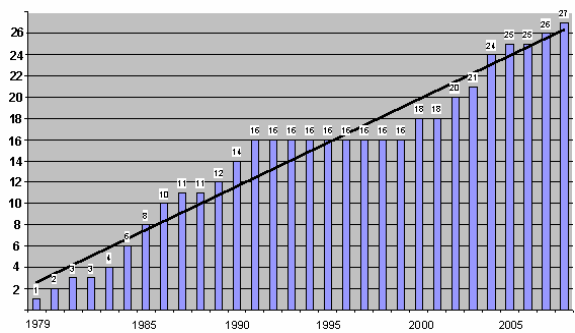
Figure 2. Number of
states with high school graduation tests 1979-2008
Source: Amrein & Berliner
(2001)
4.3
Amrein & Berliner (2001) report actual or estimated percentages of
students who take and fail high school graduation tests in eighteen high
stakes testing states. They find a considerable variability across states:
a low of 0.5% in Virginia where the basic skills graduation test is administered
in 6th grade to a high of 10% in New York and 12% in Georgia.
In addition to students who take the test and fail to graduate, considerable
numbers of students either drop out or take the GED. An examination
of data from the National Center for Education Statistics illustrates
that nationwide since 1985 there has been a more than 20% increase in
the number of GED test takers, mostly for people 19 years of age or younger.
So, while failing the graduation tests may keep a substantial number of
students from receiving a high school diploma, these tests reverberate
down in schools and influence decisions made by schools about students
and decisions made by students about schooling.
4.4 Retention in Grade. There are two grade levels at which retention
is most common: 1st grade when under-age boys are retained
to permit them time to 'mature', and again in 8th and 9th
grade when students are on the cusp of entering high school. Students
of color are retained at high rates and there is an unhealthy interaction
between grade retention and the presence of high stakes testing. Analyses
of the NELS data indicate the mere presence of a high stakes test is a
strong predictor of higher drop out rates (Reardon & Galindo, 2002).
4.5
Haney (2000) found, "Only 50% of minority students in Texas have been
progressing from grade 9 to high school graduation since the initiation
of the TAAS testing program. Since about 1982, the rates at which Black
and Hispanic students are required to repeat grade 9 have climbed steadily,
such that by the late 1990s, nearly 30% of Black and Hispanic students
were "failing" grade 9. Cumulative rates of grade retention in Texas are
almost twice as high for Black and Hispanic students as for White students."
One conclusion from this study is that retaining students in 9th
grade boosts the 10th grade TAAS scores (because the potential
low scorers are excluded) and in effect keeps many of these students
from every taking the test as the likelihood they will drop out of school
increases dramatically.

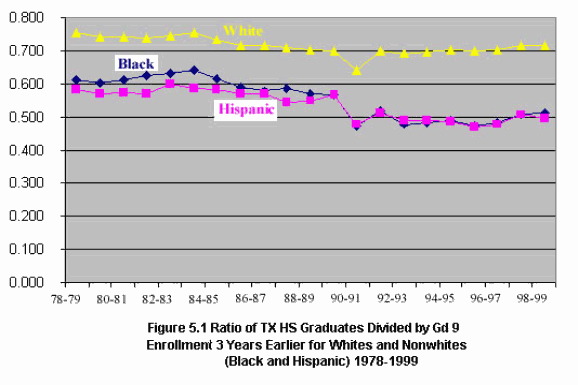
Figure 3. Illustration
Differential School Graduation
Source: Haney (2000)

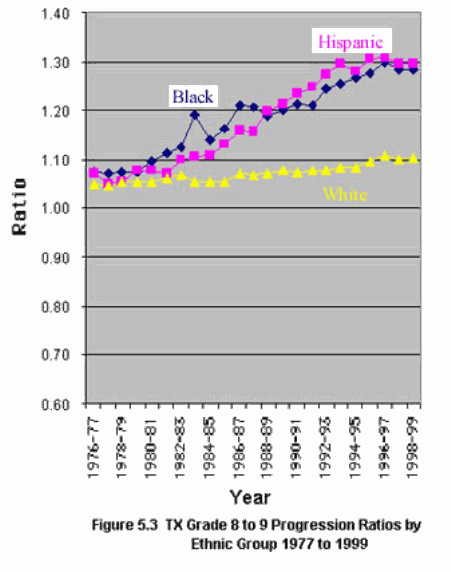
Figure 4. Illustration
of Differential Retention in Grade Effects
Source: Haney (2000)
4.6
In Massachusetts, with the implementation of a 10th grade high
stakes test the overall retention rates for 9th graders jumped
from 6.3 percent in 1995 to 8.4 percent in 2001. In 2001 twelve districts
held back 20% of 9th graders. The districts with the highest
9th grade retention rates, between 27 and 38%, enroll a majority
of nonwhite students.
4.7
In parallel to these changes in retention rates, we see increases in the
number of students dropping out of school. Being retained in grade, especially
in middle and high school, at least triples a students likelihood of dropping
out of school.
4.8
If students persist and take a high school graduation test, those who
do poorly on the test are more likely to drop out of school and
this poor test performance disproportionately affects students with high
grades. In other words, students who have by other indicators done reasonably
well in school are disproportionately influenced by poor test scores to
drop out of school. It appears that high stakes testing contributes substantially
to grade retention in middle and high school and to the failure of students
to graduate from high school.
The Bizarre Effect of Monetary
Rewards for Students
5.1
Six states give scholarships to students for high
performance on state mandated tests—California, Delaware, Michigan, Missouri,
Nevada, and Ohio. (See Quality Counts, 2001.) These scholarships provide
neither incentives nor opportunities for minority students to go to college,
in spite of the rhetoric to that effect. Scholarship money goes to students
who would have attended college anyway—they maintain the status quo with
regard to access to a college education.
5.2
Michigan's Merit Scholarship Program is a good example of this scenario.
It is worth noting that the Treasury Department administers the testing
program in Michigan. Using money from a settlement with cigarette companies,
Michigan awards scholarships based on performance on the Michigan Education
Accountability Program, or MEAP. In Michigan, one in three white, one
in five Native American, one in five Hispanic, and one in fourteen African
American test takers receive scholarships. In the Detroit area, 80% of
students in affluent suburban districts, which are white, compared to
6% of students in the Detroit city schools received scholarships. Not
only does the Michigan scholarship program reward those already college
bound, but does so by diverting money that should have gone to Michigan's
poor and indigent who are suffering from tobacco related diseases. Michigan
state is currently being sued by the ACLU, MALDEF and the NAACP for these
and other corrupting effects of high stakes testing in that state.
The
Diminishing Quality of Education for All Children, and Especially for
Minority Students as Manifest
in the "Achievement Gap" Rhetoric
6.1
There is a great deal of research to be done to fully understand the impact
of high stakes testing on the quality of education
and schooling, but the short term conclusion researchers are drawing is
that high stakes 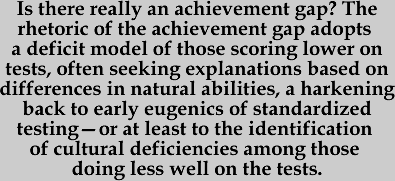 testing
not only does not improve education, but indeed diminishes its quality.
A local newspaper carried a critique of state testing from a middle school
student: testing
not only does not improve education, but indeed diminishes its quality.
A local newspaper carried a critique of state testing from a middle school
student:
The statewide test bombards the
schools with pressure… In the second week of school we get things from
the teacher like, "This was on the test last year so listen up"… The
pressure restricts teachers from doing their job… They can't help struggling
students fully understand the material because when the student starts
to finally kind of get it, it's time to move on so they can get the
entire curriculum taught. … The test pressure just about kills some
kids. I have never heard a student say, "All this pressure from the
test gets me fired up!" more often. I see kids cracking. They start
freaking out… the test is taking away the real meaning of school. Instead
of learning new things and getting tools for life, the mission of the
schools is becoming to do well on the test. (Louisville Courier
Journal,
February 10, 2003)
This
7th grader's words capture much of what researchers are finding
out about the impact of high stakes testing or what is more generally
called outcome based bureaucratic accountability. As reflected in this
student's comments, high stakes testing is contributing to the
- deprofessionalization of teachers
- narrowing of the curriculum
- adoption of curriculum driven by
tests that under-represent the purposes of schooling
- practice of only
teaching what is tested
- elimination of project based student
work, field trips, recess
- creation of unproductive stress
(See, for example, Amrein & Berliner
(2002); Clarke, Shore, Rhoades, Abrams, Miao & Li (2003); Hillocks
(2002); Madaus (1998); Mathison, Ross & Vinson (2001); MacNeil (2000);
Pedulla, Abrams, Madaus, Russell, Ramos & Miao (2003); and Vinson,
Gibson & Ross (2001) for more detailed discussions of the impact of
high stakes testing on teaching, teachers, and learning.)
6.2
High stakes testing has these negative effects on
many children, but it is especially so for children of color, because
they are disproportionately exposed to and punished by the effects of
high stakes tests. In addition, because the use and impact of tests is
ubiquitous we are diverted from thinking about causes, from thinking about
the basic technical shortcomings of the tests as well as the scoring,
standard setting and interpretation, and from the interests served by
these test-based accountability schemes. An obvious manifestation of this
diversion is the rhetoric of the "achievement gap."
6.3
Is there really an achievement gap? The rhetoric of the achievement gap
adopts a deficit model of those scoring lower on tests, often seeking
explanations based on differences in natural abilities, a harkening back
to early eugenics of standardized testing—or at least to the identification
of cultural deficiencies among those doing less well on the tests. This
rhetoric leads to a search for solutions in those deficient children and
families, solutions that by and large advocate doing more of the same
that apparently isn't working now, e.g., tutoring, grade retention, extended
school days/years and the adoption of pedagogies that deskill both teachers
and students, e.g., the adoption of direct instruction techniques and
phonics only curriculum. These strategies might lead to short term gains
in test scores, but do not result in meaningful learning.
6.4
The rhetoric of the achievement gap looks for solutions that alter children
and families of color and those living poverty, but not for solutions
that alter teachers competencies, curriculum, pedagogy, school organization
or school finance. Alternatives to the search for how to remedy poor and
minority children and families might be:
- fundamental restructuring of schools
(e.g. alternatives to authoritarian and top down management of schools)
- improvement of school climate (e.g.,
enough paper, books kids can take home and even keep, toilet paper in
the bathrooms, air conditioning, adequate space, classrooms instead
of trailers, quiet places for one-on-one interactions with students,
'Books, supplies, and lower class size!')
- curricular alternatives (e.g.,
afro-centric or latino-centric curriculum)
- efforts to decrease class size
or create small schools
- reform of school financing (e.g.
elimination of local property taxation as a major component of school
financing)
- the racial profiling inherent in
discipline policies and practices
- the Courts' role in re-segregating
schools, creating what the Harvard Civil Rights Project calls apartheid
schools,
- much greater caution about using
hastily developed, un-validated tests that are used by policy makers
in ways that violate professional standards and are frequently inaccurately
scored
The
"achievement gap" is more accurately a test score gap. It's
also an opportunity gap. And, a visit to an affluent white suburban
school and one to an urban primarily minority school will illustrate there
is a resources gap, and that same visit will also reveal an income
gap. Focusing on the test score gap without attention to these other
gaps will do little to alleviate the inherent racism in educational opportunity
and achievement.
College Entrance Tests
7.1
In the face of great odds, children of color and living in poverty do
complete high school and aspire to attend post-secondary education where
they encounter another potential set back in the form of college entrance
tests. Based on a lack of validity and the differential performance of
minority and poor children (see Figures 5 and 6) there has been increasing
criticism and rejection of both SAT and ACT scores for college admissions
(Sacks, 1999). Still, many colleges expect students to take these admissions
tests and Figures 5 and 6 illustrate the disadvantage for minority students
and the impact of income on test scores. With regard to the impact of
family income on test scores, middle class children are less likely to
gain advantage than are poor or very wealthy children. Sacks concludes,
"there is little doubt that the prevailing paradigm about merit has consistently
reproduced social and economic advantages for the "dukes of the system,"
the relatively few who conform to widely held views of merit" (1999, p.264).
|
Verbal Math Total
Ethnic Group
African American
or Black 430 427 857
Mexican or Mexican
American 446 457 903
Puerto Rican 455 451 906
Other Hispanic
or Latino 458 464 922
Amer. Indian or
Alaskan Native 479 483 962
White 527 533 1060
Asian, Asian Amer.,
Pacific Islander 501 569 1070
Other 502 514 1016
Family Income
Less than
$10,000/year 417 442 859
$10,000 -
$20,000/year 435 453 888 +29
$20,000 -
$30,000/year 461 470 931 +43
$30,000 -
$40,000/year 480 485 965 +34
$40,000 -
$50,000/year 496 501 997 +32
$50,000 -
$60,000/year 505 509 1014 +17
$60,000 -
$70,000/year 511 516 1027 +13
$70,000 -
$80,000/year 517 524 1041 +14
$80,000 -
$100,000/year 530 538 1068 +27
More than
$100,000/year 555 568 1123 +55
ALL TEST-TAKERS 504 516 1020
(Approximately
1.3 million)
Figure 5. 2002
College Bound Seniors SAT Scores
Source: College Board,
College-Board Seniors National Report, 2002
|
|
Ethnicity
African-American/Black 16.8
American Indian/Alaskan
Native 18.6
Mexican American/Chicano 18.2
Puerto Rican/Hispanic 18.8
Other 19.2
Multiracial 20.9
Asian American/Pacific Islander 21.6
Caucasian American/White 21.7
Household Income
Less than $18,000/year 17.8
$18,000 - $24,000/year 18.6 +0.8
$24,000 - $30,000/year 19.4 +0.8
$30,000 - $36,000/year 19.9 +0.5
$36,000 - $42,000/year 20.4 +0.5
$42,000 - $50,000/year 20.8 +0.4
$50,000 - $60,000/year 21.3 +0.5
$60,000 - $80,000/year 21.8 +0.5
$80,000 - $100,000/year 22.4 +0.6
More than $100,000/year 23.3 +0.9
ALL TEST-TAKERS 20.8
(1.1 million test-takers)
Figure 6. 2002 College Bound
Seniors ACT Scores
Source: ACT High
School Profile Report: H.S. Graduating Class of 2002 National
Report
|
7.2
College admissions scores are used for more than admissions, however.
Scholarship awards are also based on SAT or ACT scores. In a letter to
Florida's Governor Jeb Bush, Fairtest, MALDEF and others outline the problems:
While
African Americans comprised 14.4% of all SAT and ACT takers, they received
only 3% of all Academic Scholars Awards (100% funding) and only 8.3%
of Merit Scholarship Awards (75% funding). Latinos, who made up 13.7%
of all test takers, earned only 8.7% of the Academic Scholars Awards
and 12.3% of Merit Scholarships. White students, by contrast, comprised
53.4% of test takers, yet received 76.3% of the Academic Scholars Awards
and 71.5% of Merit Scholarships.
The
use of SAT and ACT score cut-offs to determine eligibility is a major
reason why proportionately few African American and Latino students
received these lucrative scholarships. Students must score 1270 or higher
on the SAT, or 28 or higher on the ACT, in order to qualify for Academic
Scholars; the Merit Scholarship Award eligibility is set at a SAT of
920 or an ACT of 20. Yet in Florida the average SAT score was 857 for
African Americans and 952 for Latinos, both of which are more than 300
points below the cut-off for the Academic Scholars Award. For Whites
in Florida, the average score was 1044. Other measures of academic preparation,
such as grades, do not demonstrate such a great racial disparity. It
is the high test score minimums, particularly for the Academic Scholars
program, that put receipt of these awards far out of the reach of many
students of color. (FairTest, 2001)
7.3
The move away from needs-based and toward merit-based, such as in the
Florida example, is happening in all parts of the country with similar
results. In the Introduction to their edited collection, Heller &
Marin (2002) parody the deleterious effects of such scholarships:
Imagine someone reacting to higher education's current situation by saying
that what we needed were large new programs to subsidize white and middle-
to upper-income students to attend college, and that it was not necessary
to raise need-based aid even enough to cover new tuition increases.
We would give some minority students entering awards because of their
relatively high grade point averages from inferior segregated schools.
However, we will take their aid away when they cannot get a "B" average
in a vastly more competitive college setting and blame them for not
being up to the task. A huge amount of money would go into this new
program, far more than was spent for the need-based scholarships in
some states. We would get the money from an extremely regressive tax-a
state lottery that drew money disproportionately from poor and minority
players. In other words, poor blacks and Latinos would end up paying
a substantial part of the cost of educating more affluent white students,
who would have gone to college even if they had not had the additional
financial incentive. And to add insult to injury, colleges would cut
their own financial aid funds, or shift these resources to give more
money to high scoring students. In cases where the financial aid made
more students eager to go to a particular institution in the state,
rather than an out-of-state school where they would have to pay tuition,
the in-state institution could raise its selectivity ratings by excluding
students with lower scores, students who would usually be minority and
from less affluent families.
Professional Licensure
Tests
8.1
For minority and poor students who pursue professional
degrees, graduating from high school, getting into college, and being
able to afford it may mean being faced with yet more standardized tests
to obtain a license to practice their chosen profession. For example,
if a person aspires to be an accountant, doctor, lawyer, teacher, social
worker, or police officer, s/he must pass a standardized test required
either by a professional association or a state regulatory agency.
8.2
In 1994, the Journal of the American Medical Association reported that
women and minorities were more likely to fail Part I of the National Board
of Medical Examiners test (Dawson, 1994). In 1996, the Louisiana State
Police Commission agreed to discontinue a written entrance exam for police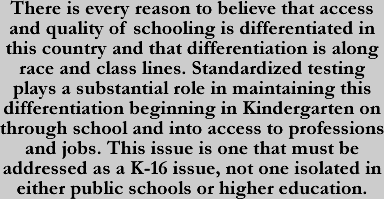 cadets and to develop a new test that does not discriminate against African
Americans in a settlement with the U.S. Department of Justice. After repeated
tries, 97% of whites and 78% of African American pass the bar exam as
reported in a study by the Law School Admission Council in 1998. In the
late 1980s it was clear the most commonly used teacher test, the National
Teachers Examination, barred disproportionate numbers of minority teacher
candidates from teaching (Pritchy-Smith, 1987). This trend continues as
forty-two states now require a teacher licensure test. In 1999, PRAXIS
passing rates nationwide for white candidates were 82% and 46% for African
Americans. A National Research Council report on teacher testing finds
the tests lacking in validity, job-relatedness and likely to compound
the desire to attract more minorities to the teaching profession (Mitchell,
Robinson, Plake & Knowles, 2001). And so the story goes for other
employment related tests for dockworkers, insurance agents, plumbers,
pharmacists, and so on.
cadets and to develop a new test that does not discriminate against African
Americans in a settlement with the U.S. Department of Justice. After repeated
tries, 97% of whites and 78% of African American pass the bar exam as
reported in a study by the Law School Admission Council in 1998. In the
late 1980s it was clear the most commonly used teacher test, the National
Teachers Examination, barred disproportionate numbers of minority teacher
candidates from teaching (Pritchy-Smith, 1987). This trend continues as
forty-two states now require a teacher licensure test. In 1999, PRAXIS
passing rates nationwide for white candidates were 82% and 46% for African
Americans. A National Research Council report on teacher testing finds
the tests lacking in validity, job-relatedness and likely to compound
the desire to attract more minorities to the teaching profession (Mitchell,
Robinson, Plake & Knowles, 2001). And so the story goes for other
employment related tests for dockworkers, insurance agents, plumbers,
pharmacists, and so on.
Building a K-16 Response
to the Disadvantage Created by Standardized Testing
9.1
There is every reason to believe that access and quality of schooling
is differentiated in this country and that differentiation is along race
and class lines. Standardized testing plays a substantial role in maintaining
this differentiation beginning in Kindergarten on through school and into
access to professions and jobs. This issue is one that must be addressed
as a K-16 issue, not one isolated in either public schools or higher education.
9.2
A number of professional organizations that represent K-12 educators and
professors have developed policy statements reflecting caution and concern
about the impact of standardized testing, although these statements focus
on testing in K-12. For example, the American Educational Research Association
(AERA), American Psychological Association (APA), American Evaluation
Association (AEA), International Reading Association (IRA), National Council
for Teachers of English (NCTE), National Council for Teachers of Mathematics
(NCTM), College and University Faculty Assembly of the National Council
for the Social Studies (CUFA/NCSS) have issued statements that caution
against the use of singular measures for important educational decision-making;
outline the detrimental effects of tests on teaching and learning; and
point out the inherent racism and classism of standardized tests. (See
http://www.eval.org/hstlinks.htm
for a list of organizations with such statements.) These statements, as
well as the complementary research agendas and political action campaigns,
represent one step in building solidarity among practitioners (K-12 teachers
and administrators) and researchers.
9.3
This K-16 alliance also includes parents, and the rise of grassroots organizations
that combine the knowledge and resources of educators, researchers and
parents are on the rise. (See http://www.eval.org/hstlinks.htm for a list of grassroots organizations, many of which are regional or
state based, but some are national in scope, such as the Rouge Forum or
the fledgling ACT NOW, Advocates for Children and Teachers National Organizing
Workshop.) Some grassroots organizing and resistance to standardized testing
has been facilitated by Fair Test, a not for profit advocacy organization
devoted for many years to "ending the abuses, misuses and flaws of standardized
testing and to ensur[ing] that evaluation of students and workers is fair,
open, and educationally sound. [Fairtest] places special emphasis on eliminating
the racial, class, gender, and cultural barriers to equal opportunity
posed by standardized tests, and preventing their damage to the quality
of education. " (See http://www.fairtest.org.)
Fair Test sponsors the Assessment Reform Network (ARN), "a national project
created to support parents, teachers, students and others who are working
to end the overuse and misuse of standardized testing in public education
and to promote authentic forms of assessment." The goal of the ARN "is
to open the doors to disadvantaged children by removing barriers to achievement,
while improving the quality of education for everyone," through facilitating
an exchange of ideas, resources and strategies among a wide audience.
9.4
Researchers are now beginning to see the common threads that can support
examination and critique of testing as it employed across the K-16 educational
spectrum. Elsewhere I have described the hegemony of accountability that
is test-driven and illustrated how this is manifest in both K-12 and post-secondary
contexts (Mathison & Ross, 2002).
Accountability is a means for
controlling both procedures and outcomes in complex, bureaucratic
environments. Education (primary, secondary and tertiary) is now in
large part controlled through accountability schemes that are devised
by those outside of schools and universities and represent a coalescing
of political-business interests. The hegemony of that accountability
lies in the particular interests served (those of political-business
elites) which are often at odds with the interests of the public good,
and the individuals who inhabit schools and universities. Accountability
need not be hegemonic, but counter-hegemonic accountability requires
a sharing of power and willingness on the part of the many to assert
their right to determine what is good and right. Collective action
by the many is necessary to counter the hegemonic interests of the
few.
There
is little reason to believe that current test based reforms in pre-collegiate,
collegiate and professional education will redress the inequities between
white and minority students and between those living in poverty and those
not. Indeed this testing has the potential to further deepen and divide
Americans along race and class lines. These deep divisions are long standing
and often seem intractable, and thus call for a political action-oriented
response across the span of K-16 education.
References
Amrein, A. L. & Berliner, D. C.
(2002). High-stakes testing, uncertainty, and student learning Education
Policy Analysis Archives, 10(18). [Online]. Available:
http://epaa.asu.edu/epaa/v10n18
Association for Childhood Education
International (1991). On standardized testing: A position paper of the
Association for Childhood Education International. Childhood Education.
Spring, 130-142.
Clarke, M., Shore, A., Rhoades, K.,
Abrams, L., Miao, J. & Li, J. (2003). The perceived effects of
state mandated testing programs on teaching and learning: Findings from
interviews with educators in low-, medium-, and high-stakes states.
Boston: NBETTP. [On-line]. Available at http://www.bc.edu/research/nbetpp/reports.html
Dawson, B. (1994). Performance on
the National Board of Medical Examiners Part I Examination by men and
women of different race and ethnicity, Journal of the American Medical
Association (JAMA), 272(9), 674-9.
Dorn, S. (2003). High-stakes testing
and the history of graduation. Education Policy Analysis Archives,
11(1). [Online]. http://epaa.asu.edu/epaa/v11n1/
FairTest (2001, December) Letter to
Governor Jeb Bush. [Online]. Available: http://fairtest.org/pr/Bright_Futures_lttr.html
Haney, W. (2000). The myth of the
Texas miracle in education. Education Analysis Policy Archives, 8
(41) [On-line]. Available: http://epaa.asu.edu/epaa/v8n41/
Heller, D. E. & Marin, P. (2002)
(Eds.) Who should we help? The negative social consequences of
merit aid scholarships. Harvard Civil Rights Project. [Online] Available:
http://www.civilrightsproject.harvard.edu/research/meritaid/fullreport.php
Heubert, J. P. & Hauser, R. M.
(1999). High stakes: Testing for tracking, promotion, and graduation.
Washington, D.C.: National Academy Press.
Hillocks, Jr., G. (2002). The testing
trap: How state writing assessments control learning. New York: Teachers
College Press.
Lee, V. E. & Burkham, D. T. (2002)
Inequality at the starting gate. Washington, DC: Economic Policy
Institute.
Madaus, G. (1998). The distortion
of teaching and testing: High-stakes testing and instruction, Peabody
Journal of Education, 65, 29-46.
Mathison, S. (1991). Implementing
curricular change through state-mandated testing: Ethical issues. Journal
of Curriculum and Supervision, 6, 201-212.
Mathison, S. & Ross, E. W. (2002)
The hegemony of accountability in schools and universities. Workplace:
A Journal of Academic Labor. [On-line] Available: http://www.louisville.edu/journal/workplace/issue5p1/mathison.html
Mathison, S., Ross, E. W. & Vinson,
K. D. (2001). Defining the social studies curriculum: The influence of
and resistance to curriculum standards and testing in social studies.
In E. W. Ross (Ed.), The social studies curriculum: Purposes, problems,
and possibilities. Albany, NY: SUNY Press.
Mitchell, K. J., Robinson, D. Z.,
Plake, B. S. & Knowles, K. T. (2001). (Eds), Testing teaching candidates:
The role of licensure tests in improving teacher quality. Committee
on Assessment and Teacher Quality, Center for Education, Board on Testing
and Assessment, National Research Council. [Online] Available: http://www.nap.edu/books/0309074207/html/
McNeil, L. M. (2000). Contradictions
of school reform: Educational costs of standardized testing. New York:
Routledge.
Noble, A. J., & Smith, M. L. (1994).
Old and new beliefs about measurement-driven reform: "Build it and they
will come." Educational Policy, 8(2), 111-136.
Pedulla, J., Abrams, L., Madaus, G.,
Russell, M., Ramos, M. & Miao, J. (2003) The perceived effects
of state mandated testing programs on teaching and learning: Findings
from a national survey of teachers. Boston: NBETTP. [On-line]. Available
at http://www.bc.edu/research/nbetpp/reports.html
Pritchy-Smith, G. (1987). The effects
of competency testing on the supply of minority teachers: A report prepared
for the National Education Association and the Council of Chief State
School Officers. Washington, DC: National Education Association.
Quality Counts 2001. (2001). Education
Week [On-line]. Available: http://www.edweek.org/sreports/qc01/
Reardon, S. F. & Galindo, C. (2002)
Do high stakes tests affect students' decision to drop out of school?
Evidence from NELS. Paper presented at the annual meeting of the American
Educational Research Association, New Orleans, April 2002.
Vinson, K. D., Gibson, R., & Ross,
E. W. (2001). High-stakes testing and standardization: The threat to authenticity.
Monographs of the John Dewey Project on Progressive Education, 3(2).
[On-line]. Available at http://www.uvm.edu/~dewey/monographs/ProPer3n2.html
|
 Study, Kindergarten Cohort (ECLS-K), Lee & Burkam (2002) conclude:
"There are substantial differences by race and ethnicity in
children’s test scores as they begin
kindergarten. Before even entering kindergarten, the average cognitive
score of children in the highest SES group are 60% above the scores of
the lowest SES group. Moreover, average math achievement is 21% lower
for blacks than for whites, and 19% lower for Hispanics." Setting aside
the unjustified confidence in the meaningfulness of standardized test
scores for young children (Association for Childhood Education International,
1991), this report illustrates just the beginning of a lifetime of characterizations
and decisions that will be made and indeed institutionalized for children
of color and those living in poverty.
Study, Kindergarten Cohort (ECLS-K), Lee & Burkam (2002) conclude:
"There are substantial differences by race and ethnicity in
children’s test scores as they begin
kindergarten. Before even entering kindergarten, the average cognitive
score of children in the highest SES group are 60% above the scores of
the lowest SES group. Moreover, average math achievement is 21% lower
for blacks than for whites, and 19% lower for Hispanics." Setting aside
the unjustified confidence in the meaningfulness of standardized test
scores for young children (Association for Childhood Education International,
1991), this report illustrates just the beginning of a lifetime of characterizations
and decisions that will be made and indeed institutionalized for children
of color and those living in poverty. 


 testing
not only does not improve education, but indeed diminishes its quality.
A local newspaper carried a critique of state testing from a middle school
student:
testing
not only does not improve education, but indeed diminishes its quality.
A local newspaper carried a critique of state testing from a middle school
student: cadets and to develop a new test that does not discriminate against African
Americans in a settlement with the U.S. Department of Justice. After repeated
tries, 97% of whites and 78% of African American pass the bar exam as
reported in a study by the Law School Admission Council in 1998. In the
late 1980s it was clear the most commonly used teacher test, the National
Teachers Examination, barred disproportionate numbers of minority teacher
candidates from teaching (Pritchy-Smith, 1987). This trend continues as
forty-two states now require a teacher licensure test. In 1999, PRAXIS
passing rates nationwide for white candidates were 82% and 46% for African
Americans. A National Research Council report on teacher testing finds
the tests lacking in validity, job-relatedness and likely to compound
the desire to attract more minorities to the teaching profession (Mitchell,
Robinson, Plake & Knowles, 2001). And so the story goes for other
employment related tests for dockworkers, insurance agents, plumbers,
pharmacists, and so on.
cadets and to develop a new test that does not discriminate against African
Americans in a settlement with the U.S. Department of Justice. After repeated
tries, 97% of whites and 78% of African American pass the bar exam as
reported in a study by the Law School Admission Council in 1998. In the
late 1980s it was clear the most commonly used teacher test, the National
Teachers Examination, barred disproportionate numbers of minority teacher
candidates from teaching (Pritchy-Smith, 1987). This trend continues as
forty-two states now require a teacher licensure test. In 1999, PRAXIS
passing rates nationwide for white candidates were 82% and 46% for African
Americans. A National Research Council report on teacher testing finds
the tests lacking in validity, job-relatedness and likely to compound
the desire to attract more minorities to the teaching profession (Mitchell,
Robinson, Plake & Knowles, 2001). And so the story goes for other
employment related tests for dockworkers, insurance agents, plumbers,
pharmacists, and so on.

